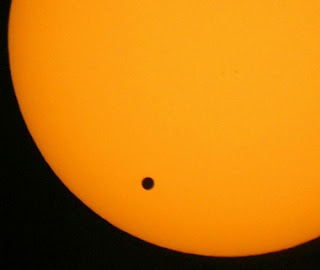- Watching Venus - June 5, 2012 06:09 am t0 14:49 PM +8GMT (Philippines Time)
Turning on the alarm clock is not required for those who wake up late in the Philippines because Venus is visible for more than 6 hours all over Philippines archipelago.
Filipinos can view a once-in-a-lifetime astronomical spectacle tomorrow, when the planet Venus makes its way across the sun.
The so-called Transit of Venus won't happen again until 2117.
Philippine Atmospheric, Geophysical, and Astronomical Services Administration (PAGASA)-Space Sciences and Astronomy Section officer-in-charge (OIC) Dario Dela Cruz said the passage of Venus will be best observed from 6:09 a.m. to 12:49 p.m. facing the eastern horizon this Wednesday.
"This event will not occur again until the next lifetime. We will have to wait for another 105.5 years to witness it," Dela Cruz said.
According to PAGASA Administrator Dr. Nathaniel Servando, Mercury and Venus transits are the only passages that are seen from Earth.
"Since the planets Mercury and Venus orbit inside the path of the Earth around the sun, they too can come between the Earth and the Sun. However, since these planets have a tiny apparent diameter as seen from Earth, the transit is seen as a small black disk moving across the face of the sun," he explained.
On the average, there are 13 transits of Mercury in a century.
Dela Cruz explained that transits of Venus occur in pairs, with more than a century separating each pair.
There are only eight events that occurred since the invention of the telescope – 1631, 1639, 1761, 1769, 1874, 1882, 2004, and the upcoming June 6 event.
Dela Cruz pointed out that the 2004 and 2012 transits form a contemporary pair separated by eight years.
The next two transits of Venus will occur on 2117 and 2125.
Aside from the Philippines, the entire transit will be visible in Greenland, North and Central America, Pacific Island, Australasia, Asia, East Africa, and most of Europe, Servando said.
He advised skywatchers that the safest way to observe a transit is to project the image of the sun through a telescope, binoculars, or pinhole onto a screen, but the event can be viewed with the naked eye using filters specifically designed for this purpose, such as an astronomical solar filter with a vacuum-deposited layer of chromium, eclipse viewing glasses, or Grade 14 welder's glass.
"An earlier method of using exposed black-and-white film as a filter is no longer regarded as safe, as small imperfections or gaps in the film may permit damaging UV rays to pass through. Also, processed color film (unlike black-and-white film) does not contain silver, and is transparent to infra-red. This may result in burns to the retina," Servando said.
"Observing the sun directly without filters can cause a temporary or permanent loss of visual function, as it can damage or destroy retinal cells," he added.
Venus transits have been significant in gaining the first realistic estimates of the size of the solar system, and it continue to be of relevance to other ongoing scientific exploration.










